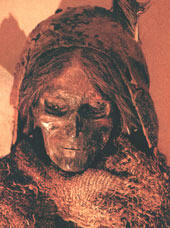 Cherchen Man, who died around 1000 BC, appears to be as Scottish as square sausage tall, dark-haired, clad in a red tunic and tartan leggings and sporting a beard as ginger as a burning fox. His DNA attests to his Celtic origins. So why on earth, then, was his mummified corpse discovered buried in the barren sands of the Taklamakan Desert, in the far-flung Xinjiang region of western China?
Cherchen Man, who died around 1000 BC, appears to be as Scottish as square sausage tall, dark-haired, clad in a red tunic and tartan leggings and sporting a beard as ginger as a burning fox. His DNA attests to his Celtic origins. So why on earth, then, was his mummified corpse discovered buried in the barren sands of the Taklamakan Desert, in the far-flung Xinjiang region of western China?
Its a question that still has experts scratching their heads, especially since Cherchen Man is just one of hundreds of ancient desiccated corpses of European origin found in the Tarim Basin in western China over the last 25 years. His remains, along with others, are now kept in a museum in the Xinjiang provincial capital of Urumqi, which also houses a reconstruction of how this intrepid traveller might have looked before he died.
It had been well known and accepted that Celtic influence stretched far and wide at the civilizations peak around 300 BC, from Scotland in the north to Ireland in the west, southern Spain and Italy in the south and parts of Poland, Ukraine and central Turkey in the east. But few experts expected to discover the remains of humans of Celtic descent in central Asia, almost as far east as Tibet. Theyve been described as among the most important archaeological finds of the past quarter century, and point to an ancient connection having evidently existed between east and west as early as the Bronze Age.
The burial site of Cherchen Man and his people bore other hallmarks of Celtic culture, such as large standing stones that look like British dolmens. He was found buried with what appears to be his family three women and a baby, all of whom have equally European features. One womans hair is light brown, and it looks like it was freshly brushed and braided before her mummification.
An even older Tarim mummy than Cherchen Man is the 4,000-year-old Loulan Beauty discovered near the town of Loulan who too has long, flowing fair hair, and features that look to be of Nordic origin. All of these European migrants seem to have been peaceful folk, since very few weapons have been found in their graves, or valuable goods that suggest evidence of a caste system. Nonetheless, they might have done well to learn the meaning of the name of the Taklamakan Desert before they made their long journey there you go in, it translates, and never come out.
Picture by Farrukh Younus. All rights reserved.



